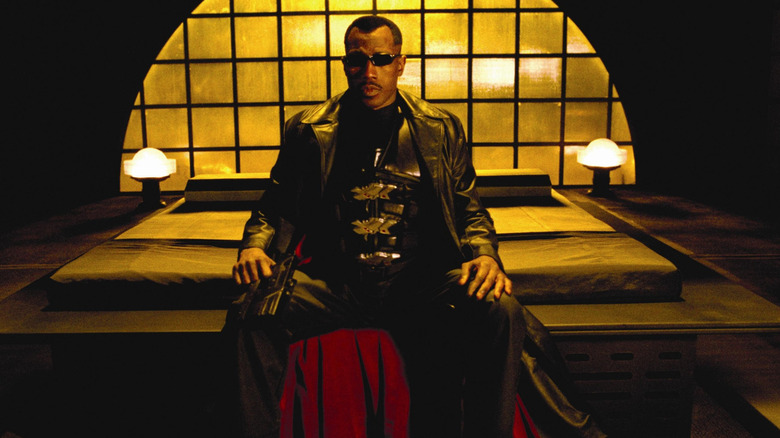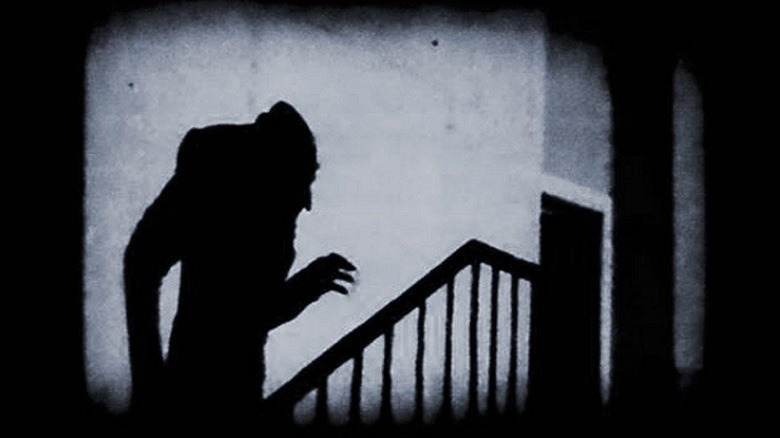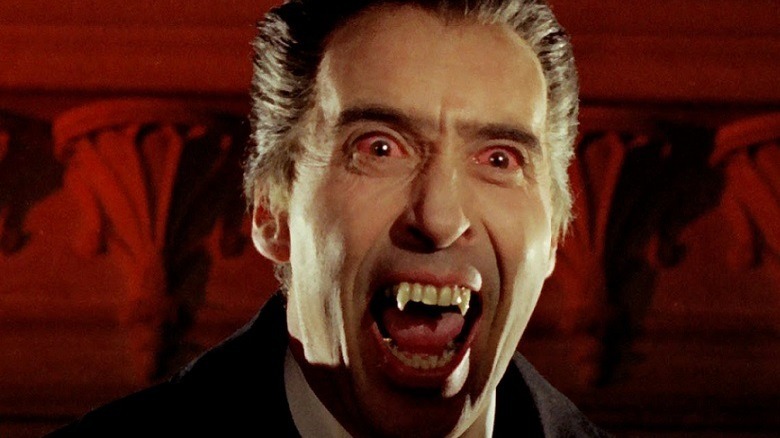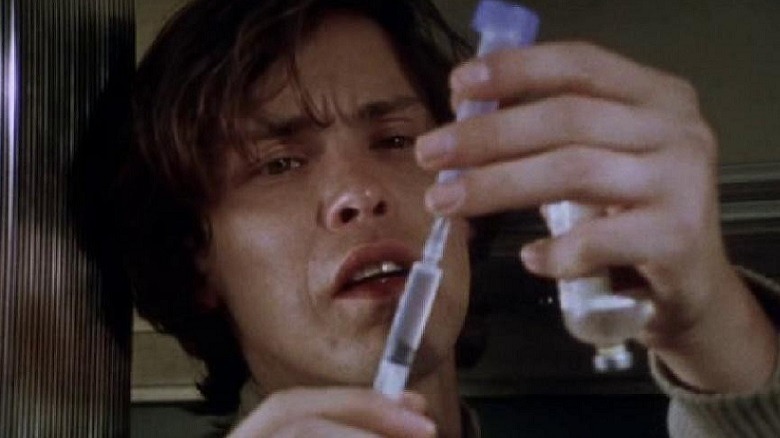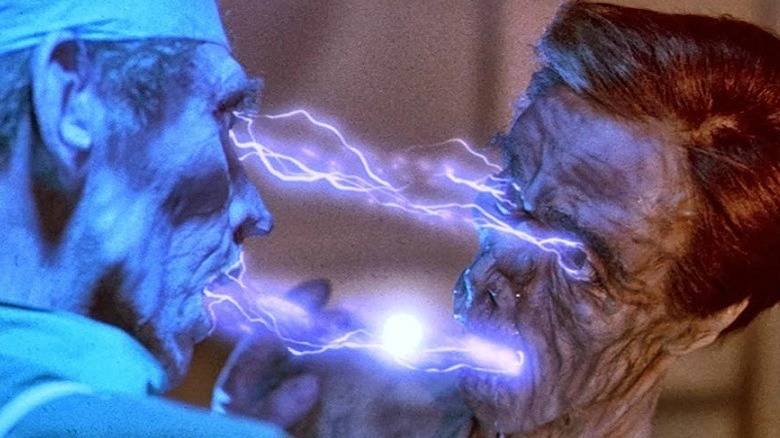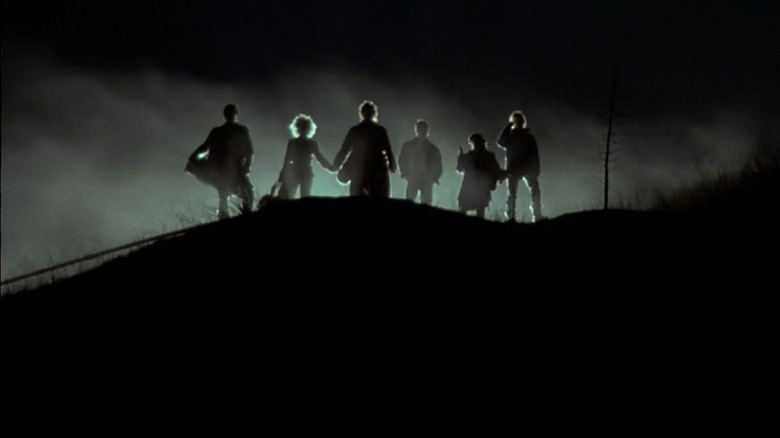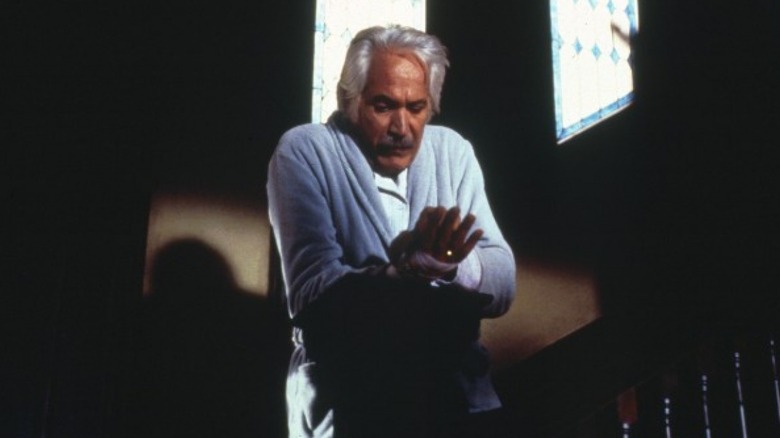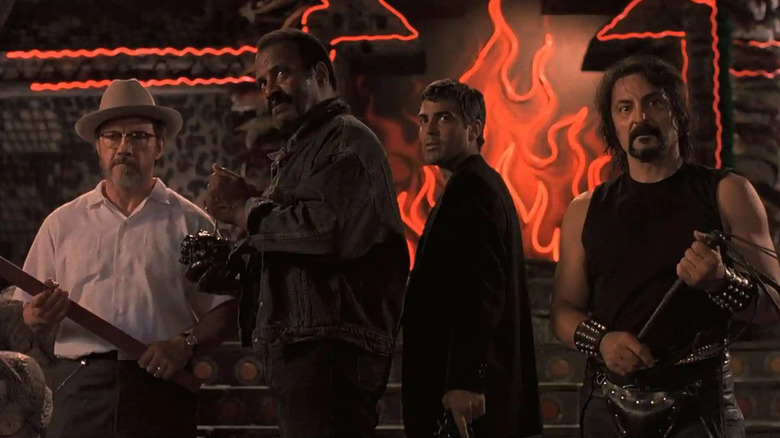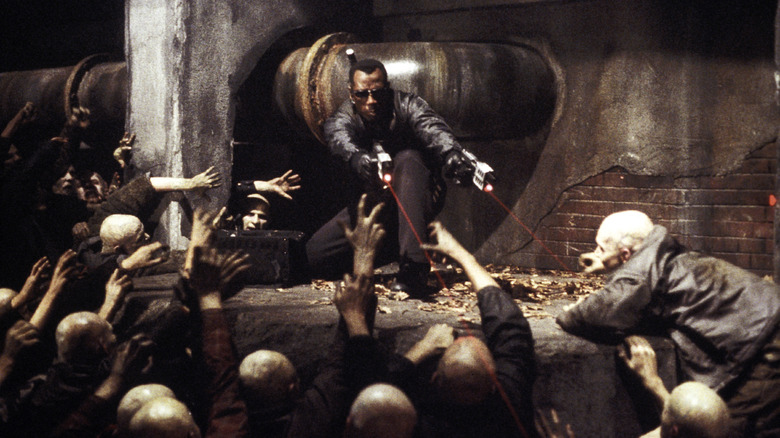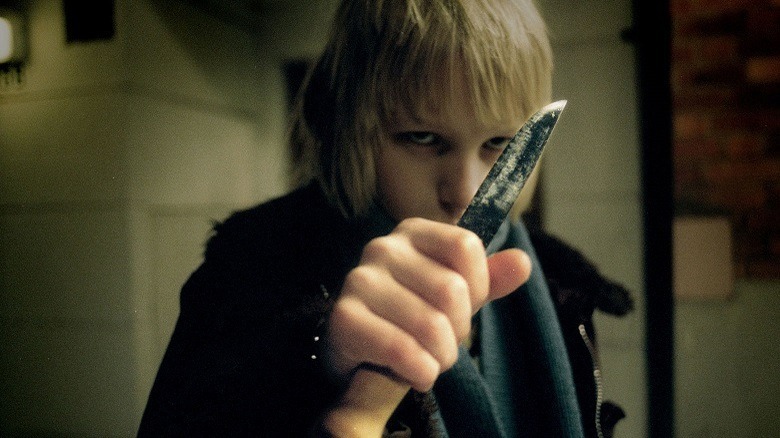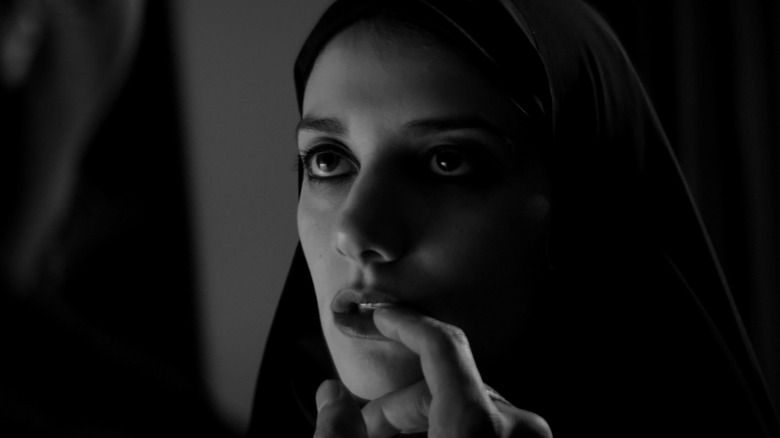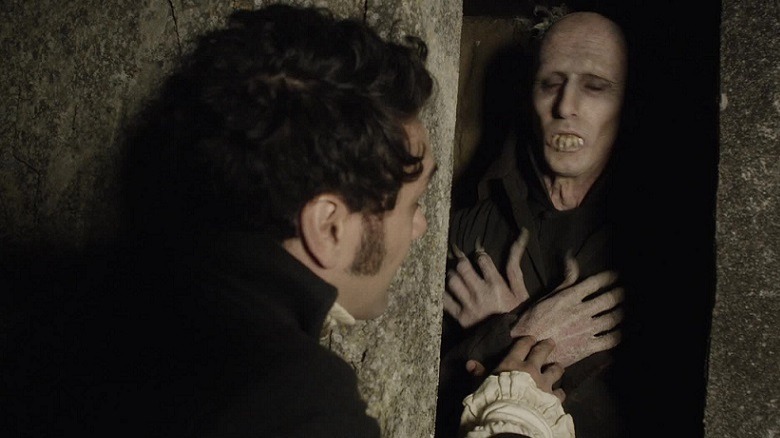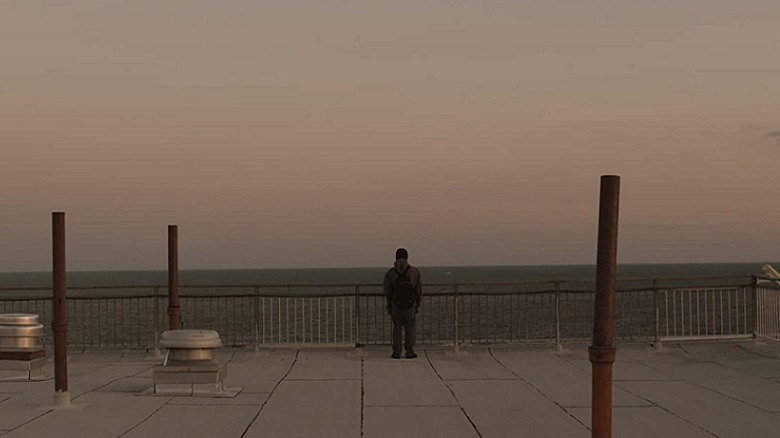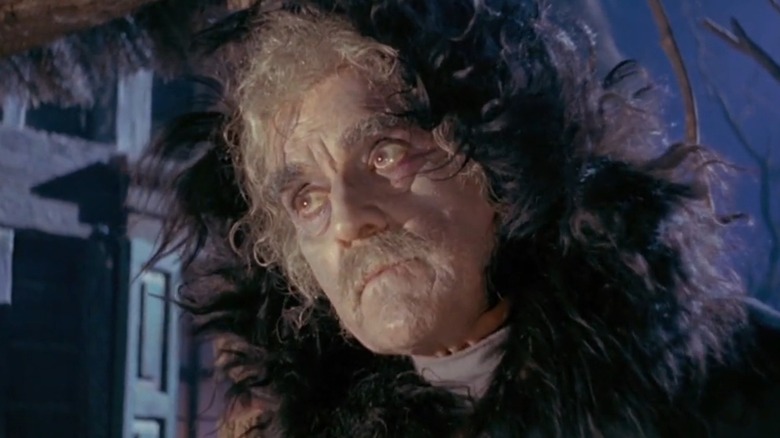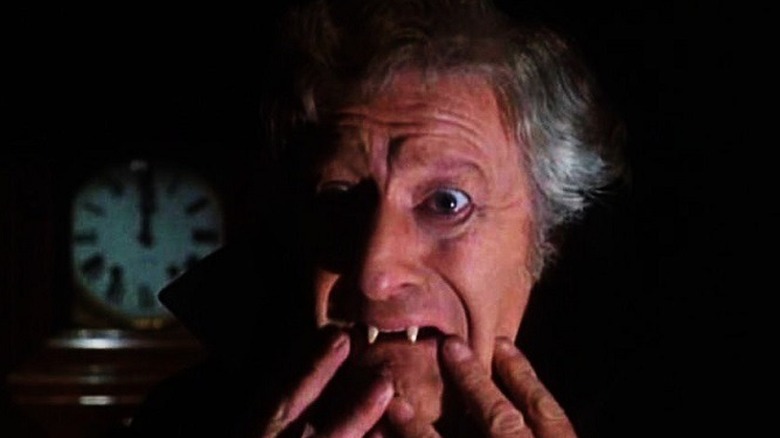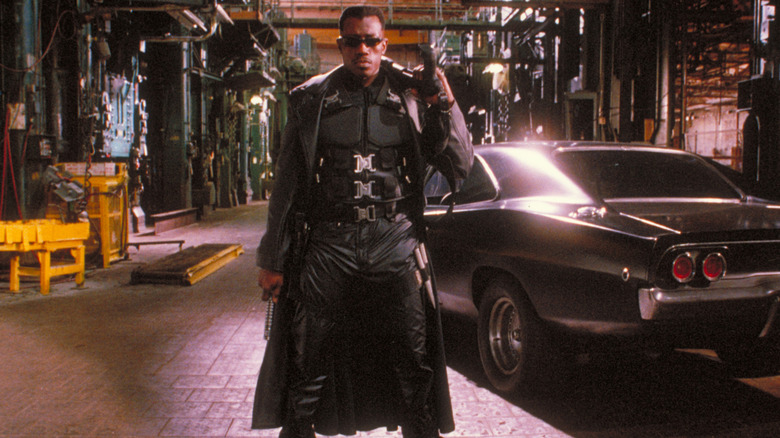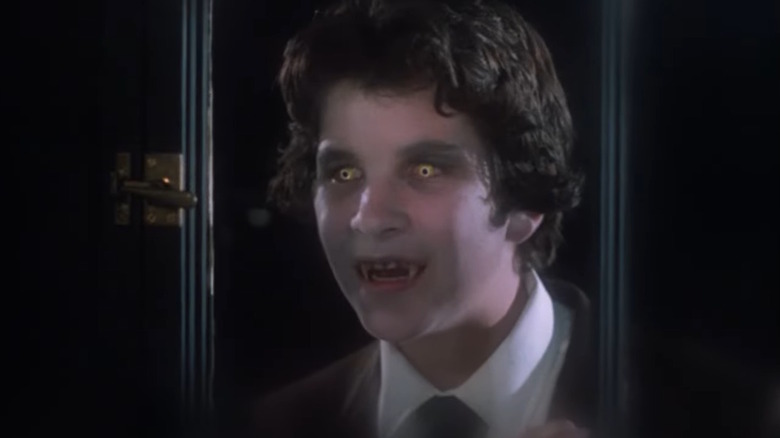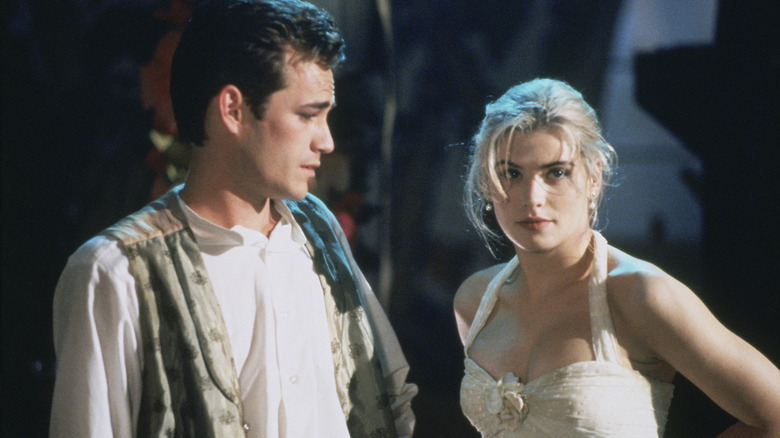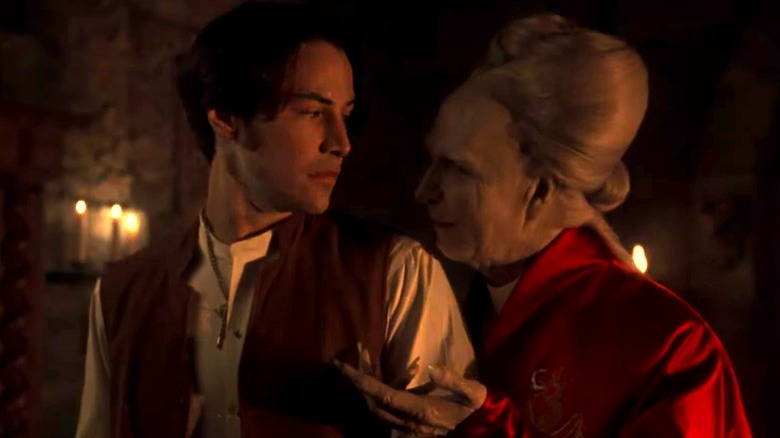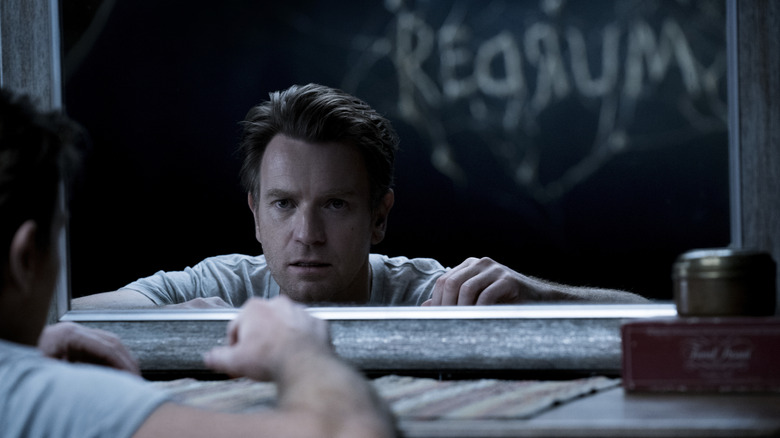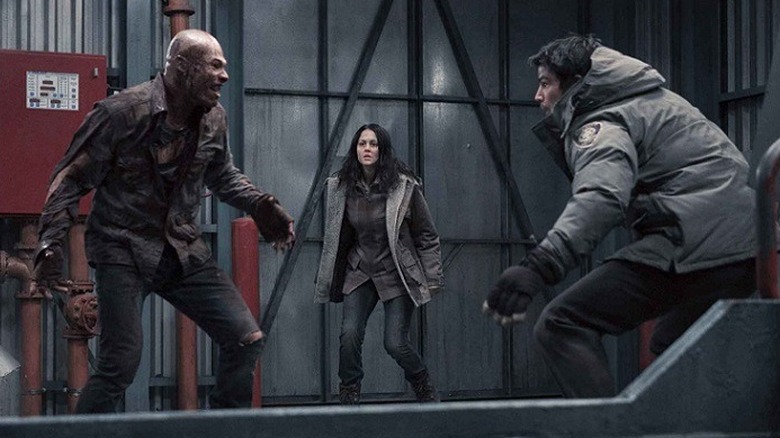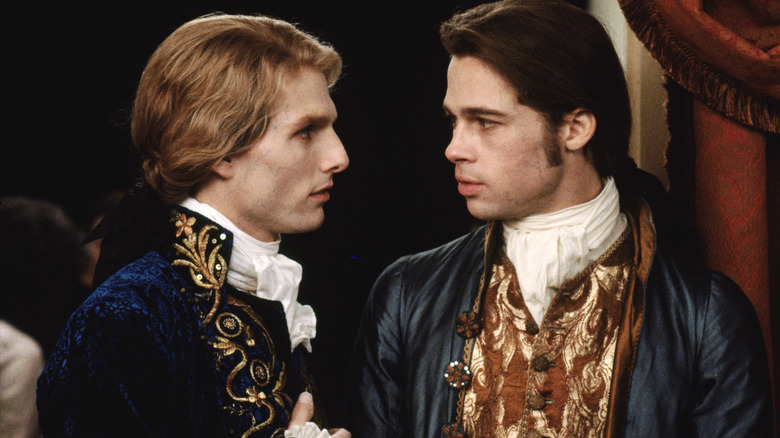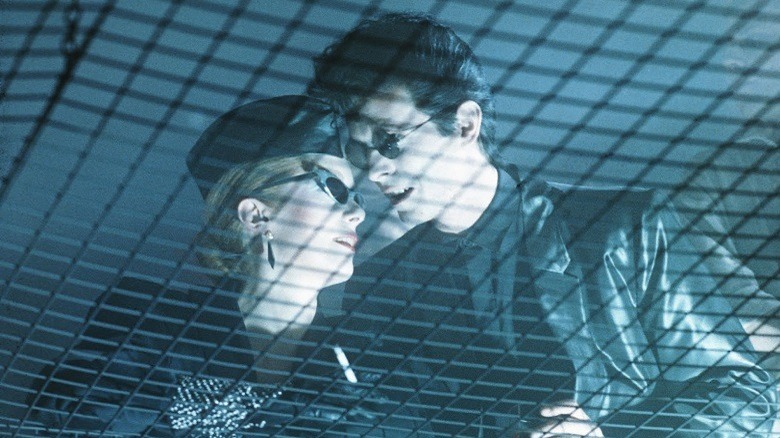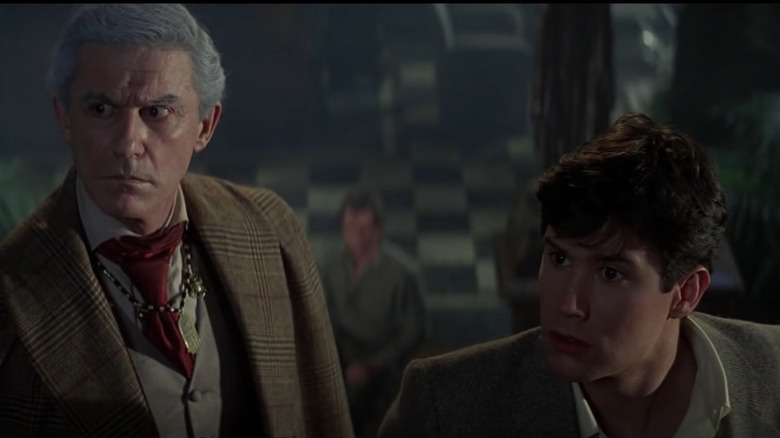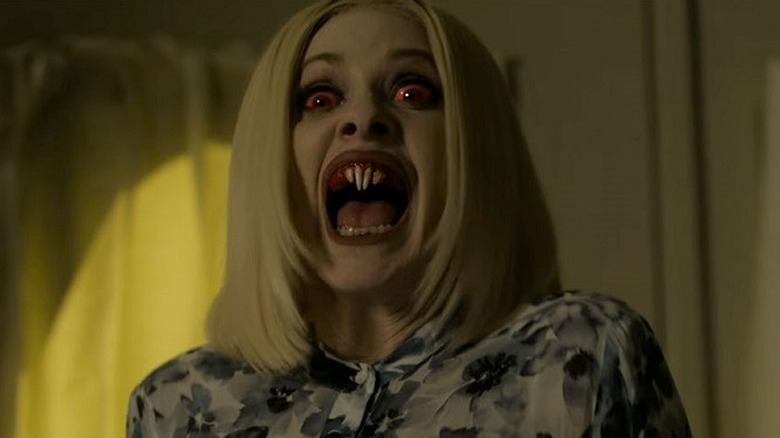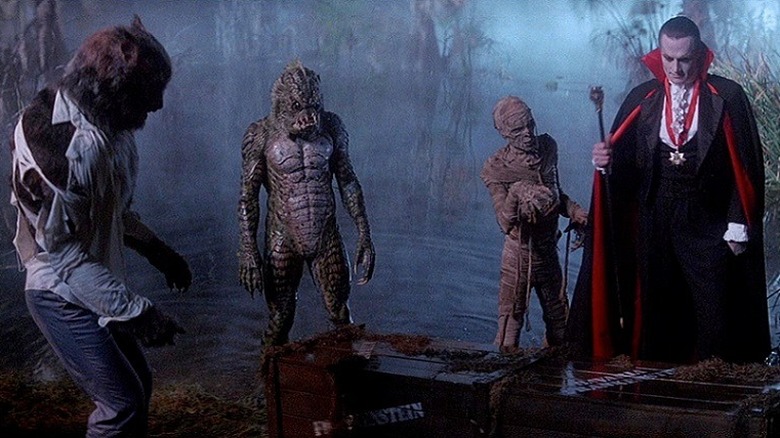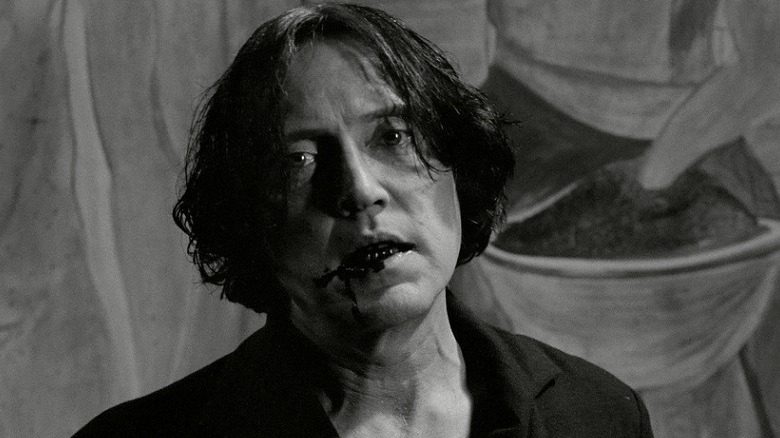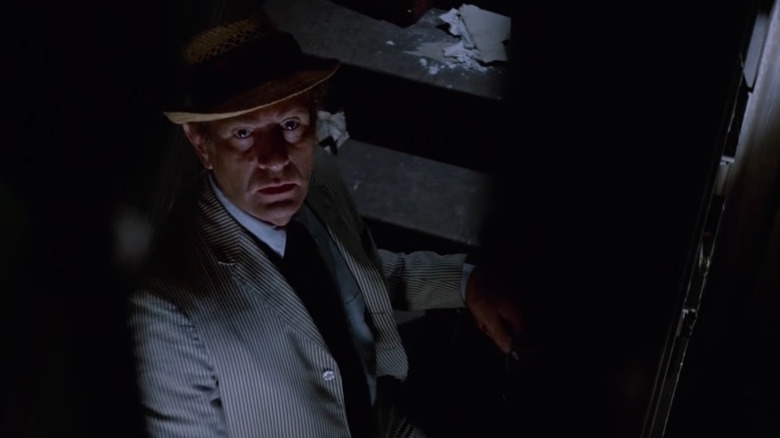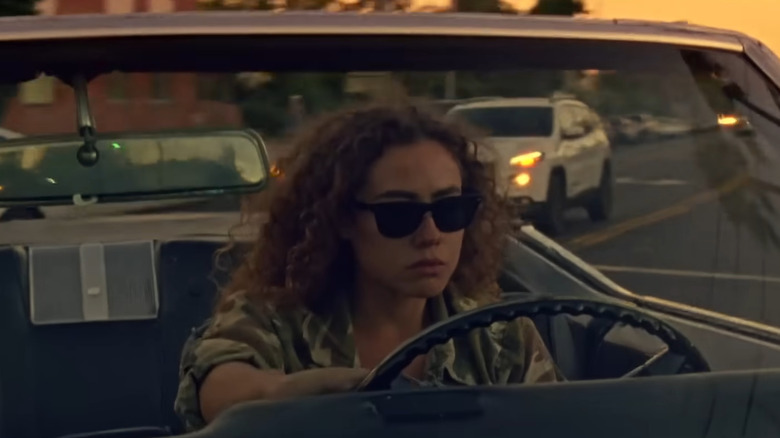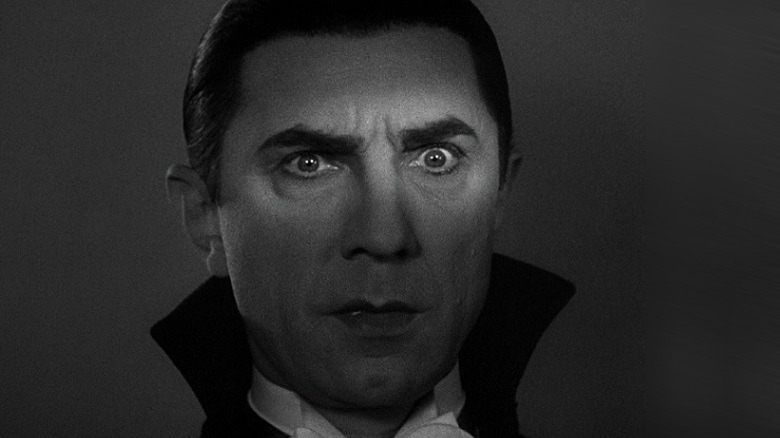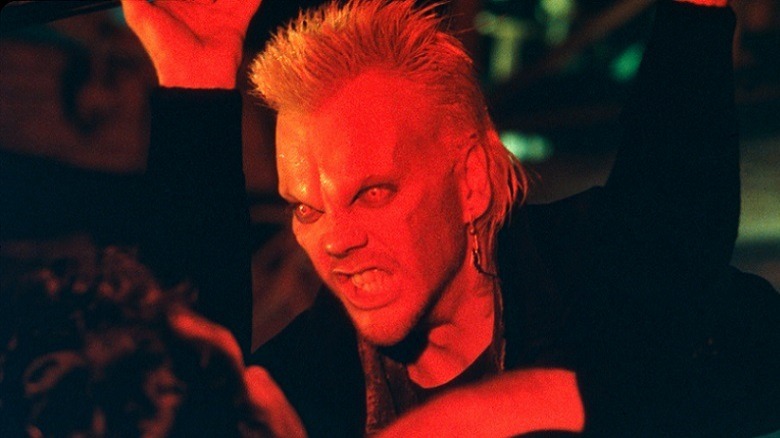The 30 Best Vampire Movies Of All Time
Every culture has its own flavor of the vampire myth, from the Icelandic "draugur" — corporeal undead who guard their treasures — to the Romani "mullo," or ghouls who feed on the blood of those who caused their demise. That considered, it's no surprise that the vampires in our cinema are as varied as the legends that spawned them.
On this list, we'll meet seductive space vampires, misguided vampire wannabes, and angst-ridden, cape-swishing romantics. We'll encounter undead skateboarding feminist icons, vampires who get their powers through bizarre biomechanical gadgetry, feral beasts stripped of their humanity, monsters well beyond any chance at redemption, cinema icons who paved the way for numerous, inferior imitators, and more, all in the best vampire movies of all time.
So, as a certain highly regarded, felt-covered, altogether less sinister member of the vampire community might say, "One vampire movie, ha ha ha. Two vampire movies, ha ha ha..."
Nosferatu
Emerging first from the shadows is Count Orlok, "The Bird of Death." He's the first vampire to make celluloid his home, and naturally must be first on this list of thirsty movie undead. Clearly based on Bram Stoker's "Dracula" (in terms of story, not appearance), Orlok possesses neither the physical characteristics nor the charm of his Transylvanian neighbor. Whereas Dracula can pass as a man, Nosferatu is more monstrous in visage. Pale skinned with a mouthful of vicious fangs, his fingers tipped with long raking claws, Orlok barely looks human. He's a baser creature than the Count, with his primary interests lying solely in feeding and killing.
"Nosferatu" is regarded as one of the defining films of German Expressionism. The iconic shot of Orlok ascending an intended victim's stairs is one of the most recognizable (and spoofed) images from the entire movement. The whole film is filled with striking imagery, though, in particular shot in which Orlok emerges from his coffin to stand bolt upright, a highlight that still chills even now.
Stoker's estate sued director F.W. Murnau because of the striking similarities between "Nosferatu" and Stoker's novel, and ordered all copies of the film destroyed. However, like any vampire worth his salt, Orlok lives on.
Horror of Dracula
Having grown up on a diet of Hammer Studios movies in the '70s and '80s, it would be a sin for this Brit to not include at least one of them on this list, and "Dracula" ("Horror of Dracula" in the U.S.) is the first and best. Christopher Lee has the amazing talent of being able to completely inhabit any character he plays, be it Lord Summerisle in "The Wicker Man," Saruman in Peter Jackson's "Lord of the Rings" trilogy or, in this case, the dreaded Count Dracula himself.
Whereas Bela Lugosi had portrayed the prime vampire for Universal Studios three decades before and gave him a distinct European elegance, Lee's Dracula brought an alluring sexuality to the role. Here was a Dracula you wouldn't object to being bitten by, an immortal capable of gliding between a refined gentleman and a savage beast as effortlessly as a bat. This Dracula was seductive and mysterious, and in Lee, a dominating physical presence. The genius of this adaption, though, is the casting of Van Helsing. When you have an actor as powerful as Lee on the screen, only an actor like Peter Cushing makes a convincing match.
Lee would reprise the role of the Count six more times over his career, but each film was lesser than the last, draining the very last drops of lifeblood from an increasingly watered-down franchise.
Martin
It's easy to forget that George A. Romero had more to offer the world of horror than just his Trilogy of the Dead, and the oft-forgotten "Martin" is a reminder of the man's talent at both writing and directing.
"Martin" tells the tale of Martin Mathias, a young and troubled man who believes himself to be a vampire. Opening on Martin onboard a sleeper train as he slices open the forearm of a sedated woman and drinks her blood, it's a powerful and unforgettable introduction to the character.
Romero leaves Martin's true nature deliberately vague, with the audience left to decide whether he's a vampire or not. Martin has visions of torch-wielding mobs and assorted vampiric tropes, but it's unclear whether they're just delusions or his actual memories. "Martin" is full of religious allegory, and forces viewers to question whether the fantasies are Martin's fault, or that of those around him. Either way, it's a powerful movie that ends on a bleak and deliberately ambiguous note. It's often disregarded as part of Romero's oeuvre due to its thought-provoking nature and sedate pacing, but it's his strongest with regard to both narrative and visuals.
Lifeforce
If the other films here could be classed as filet mignon (served rare and bloodied, obviously), director Tobe Hooper's "Life Force" is a fast food burger: disposable and flawed, but sometimes exactly what you're craving.
While, in real life, the only Brits who get to go to space are billionaires, in "Lifeforce" a joint U.S.-U.K. Space Mission encounters an alien craft containing three humanoids in suspended animation. Brought back to Earth, they reanimate and cause havoc — and only one of the astronauts on that original mission can stop them.
An adaptation of Colin Wilson's subtly titled novel "The Space Vampires," "Lifeforce" is memorable for several reasons. Henry Mancini's rousing orchestral score is a standout, feeling like it belongs to the huge sprawling sci-fi epic that "Lifeforce" is trying to be, and some of the full-size animatronic work is truly exceptional. What most people will remember most from "Lifeforce," though, is Mathilda May as the lead female space vampire, who spends most of her screen time walking around naked. She's certainly a less subtle seducer than Dracula, and meets with more success during her brief time on Earth.
Like the aforementioned burger, "Lifeforce" is as cheesy as they come, but exceptional production values and an ambitious spirit make it feel like a lost Hammer "Quatermass" film.
Near Dark
Historically, cinema had always had a certain reverence for vampires, taking a romanticized view of anguished souls cursed to walk amongst the shadows, forever denied the beauty of daylight. "Near Dark" was one of the first vampire movies to take that leather-bound rulebook and throw it into the fire. These aren't maudlin, eloquent, and elegantly dressed European vampires who bemoan their lot, but monsters who revel in their powers, lording their supremacy over mere mortals who they see as cattle.
"Near Dark" tells the tale of Caleb, a young guy in a small town who falls for — and is bitten by — attractive drifter Mae. Unfortunately, it turns out that Mae is a vampire, one of a vicious gang that travels from town to town, tearing through souls like a plague. Caleb's forced to earn their trust and learn the hard way how to live as a member of the undead.
"Near Dark" is part road movie, part Western, and part horror. The gang, led by 150-year-old Jesse Hooker (a never better Lance Henriksen, more cult leader than patriarch), are a force of nature. The vampires delight in their immortality and the powers it grants them, and are immune to the familiar trappings, like garlic and the cross. Only sunlight threatens them; in this Western, the sun acts as cavalry, dominating scenes of sun-drenched vistas.
Cronos
Even though it was his first full-length movie, "Cronos" made it apparent that Guillermo del Toro was a talent worth watching.
In this tale of resurrection and redemption, our hero (named "Jesus," in an unrefined allegory) is an antique dealer who comes across a half-a-millennia-old scarab-shaped mechanical device — the Cronos of the title — hidden inside a statue. The device latches onto Jesus, embedding itself inside him with a painful barb, and the old man is rejuvenated and granted endless life. However, this comes with a desperate thirst for blood. Jesus learns that others are searching for this device, also seeking the immortality that it can provide.
The first of two del Toro films on the list (and the first of two appearances by del Toro's muse and frequent collaborator, Ron Perlman), "Cronos," like the device itself, is a lost treasure. It's a wonderful subversion of vampire tropes, with immortality in this case passed on by bio-mechanical means; at the heart of "Cronos" is a beetle-like insect trapped inside a clockwork prison. As Jesus becomes increasingly vampiric, he becomes less human in both mind and appearance. It's an elegant work with early examples of del Toro's distinctive style, powerful performances, and a thought-provoking conclusion.
From Dusk till Dawn
Because we live in an age in which even movie trailers have their own teasers, by the time an actual film hits theaters, you've already seen a good portion of it. Filmmakers don't hesitate to give everything away in advertising, even if they're revealing major plot twists or surprises.
So, imagine walking into a cinema in 1996 to see "From Dusk till Dawn." All that you know is that it stars that lovely George Clooney from "E.R." and is written by "Pulp Fiction" director Quentin Tarantino. Imagine your surprise when the movie pulls a perfect twist; a cinematic experience to rival the best of Shyamalan's twist endings.
"From Dusk till Dawn" sees two brothers and career criminals, Seth and Richie Gecko, kidnap a family to help them escape over the Mexico border. After arriving at the club, a seedy desert inn where they hope to meet their contact, the siblings discover that the bar is a lair for frenzied vampires and are forced to fight for their lives alongside the bar's other patrons.
"From Dusk till Dawn" is an audacious piece of filmmaking, playing a trick it'd be impossible to pull off now. It also achieves the difficult feat of making an unsympathetic character — Clooney's Seth — someone to root for, and features a whole host of horror stars, including genre legend Tom Savini, in supporting roles. It's a blast.
Blade 2
Deviating from the standard trope, in "Blade," the vampires lived among us. They were organized, occupied the highest positions in society, and existed as an entirely separate community with their own hierarchy, laws, and rules. That's all established in the original movie, and "Blade 2" cuts it right apart.
A pandemic that affects only vampires transforms the undead into infectious monsters known as "Reapers." Blade, searching for his old mentor, is forced to make a truce with the vampires and team up with the Bloodpack — a cadre of elite operatives trained to find and kill him – to wipe the Reapers out.
Del Toro was hired to direct "Blade 2" because of his excellent work on the giant bug movie, "Mimic." As a huge comic book fan, del Toro turned out to be the perfect pick for the Blade franchise. The action scenes, of which there are many, are thrilling and dynamic, and the Reapers are genuinely unnerving — pale albino creatures whose entire jaws stretch to preternatural dimensions, revealing rows of vicious fangs. Guillermo wanted the creatures to be an unholy evolution of the vampire, something more demon than man. He certainly achieved his goal. "Blade 2" takes the first movie's foundation and hits the ground running, doing exactly what a good sequel should: expanding on the premise of the original, but bettering it.
Let the Right One
Adapted from the best-selling book by John Ajvide Lindqvist, "Let the Right One In" is a Nordic horror-noir set in Stockholm in the early '80s. Oskar, 12, frequently the victim of school bullies, is desperate for revenge. He befriends his neighbor Eli, a girl seemingly his own age, and soon learns the secret of her and her mysterious guardian, Håkan.
The title, inspired by a Morrissey song, is deliberately ambiguous. On one hand, it refers to the legend that a vampire may not enter a house until invited inside. On the other, it suggests that Oskar is one of the few people that Eli can let in on her deadly secret.
"Let the Right One In" is beautifully shot and genuinely touching. There's a scene in which Eli demonstrates to Oskar exactly what happens if she enters a private residence uninvited, and it brings an ugly and painful level of detail to an often-ignored detail of vampiric lore. The friendship between Eli and Oskar is charming and genuine, heightened by the incredible performances by the two leads. It's a friendship doomed to only ever end one way, but this inevitability brings a level of unexpected poignancy to the film. Stockholm has never looked as beautiful, all wide vistas of snow-covered urban sprawls — an alien setting for the more horrific scenes, giving them an unusual macabre beauty. You should let this one in.
A Girl Walks Home Alone at Night
It's not practical for vampires to travel as bats all the time — it's a terrible strain on the arms — so they're not averse to other means of transportation. A horse drawn carriage driven by a human familiar; a coffin in the hold of the good ship Demeter; a skateboard.
Set in a ghost town in Iran, "A Girl Walks Home Alone at Night" centers around Arash, a young man harassed by a local pimp owed money by Arash's father. Arash encounters — and befriends — a mysterious and enigmatic chador-clad skateboarding girl who may or may not be responsible for several deaths in the area.
Plot-wise, "A Girl Walks Home Alone at Night" treads a similar path as "Let the Right One In," but it's interesting to see the story transposed into an altogether different culture and political climate, with any element of romanticizing the vampire removed. The Girl (all she is even known as, even in the credits) is as far from the stereotypical angst-ridden Nosferatu as you can get; she's a protagonist, not a victim, and uses her powers to do what she wants, free from harm. Filming the movie in black and white was a bold choice, but a wise one — it gives the imagery a sense of timelessness, as well as making it resemble an animated graphic novel — and marks a striking debut for writer-director-producer Ana Lily Amirpour.
What we do in the Shadows
Vampires are tricky to get right in comedy, as evidenced by Leslie Nielsen's "Dracula: Dead and Loving it," a movie so bad most viewers would prefer to be staked through the heart than watch it. The basic concept of vampires is so daft that it's kind of a spoof of itself, almost beyond parody. Why "What We Do in the Shadows" works so well, however, is that it takes that pomposity and the inherent silliness to vampires and treats it with a completely deadpan attitude, making it hilarious.
"What We Do in the Shadows" is presented as a fly-on-the-wall documentary covering the everyday (or every night?) lives of vampire flatmates in Wellington, the capital of New Zealand. It follows the trials and tribulations (and accidental incinerations) of our four hapless night-dwellers, showing the mundane realities of immortality. The resident vampires are, despite their longevity, stupidly naïve about modern life, and it's from various fish-out-of-water scenarios that some delightful humor arises. It's all very well being 2,000 years old and able to transform into a bat at will, but you still need to put the bins out.
"What We Do in the Shadows" would go on to inspire an equally brilliant television series of the same name, as well as "Wellington Paranormal," a mockumentary-style production featuring the New Zealand police officers responsible for policing the supernatural.
The Transfiguration
"The Transfiguration" resembles a modern retelling of "Martin," but ends up being much more. It's a bleak tale of obsession, but also an interesting take on the vampire myth, especially how vampires are interpreted and portrayed in modern culture.
Milo is a 14-year-old boy who believes that he is a vampire. He has killed before, and has constructed a journal full of rules that he believes that he, as a member of the undead, must follow. He befriends a girl, Sophie, which puts her in jeopardy: Milo's own rules prevent taking one's own life, but he is increasingly drawn to the girl. This all takes place across a background of urban squalor and gang warfare, and it almost feels as though Milo's misguided belief is all that keeps him going; being a vampire is the protective ward that shields him from the world, and is the only way he can feel important.
It's certainly the most realistic and grounded of any of the films here — Milo's misguided beliefs are never portrayed as being anything but – but is as worthy as any of the other entries on the list. Whether he has supernatural qualities or not, Milo is a vampire. "The Transfiguration" ends in tragedy, the only way the story realistically can, but there is redemption, of a sort. All in all, this is a hidden independent gem, and deserving of its position amongst the vampiric pantheon.
Black Sabbath
Fans of Ozzy Osbourne or classic British rock probably best know "Black Sabbath" as the inspiration for the band of the same name, but It's worth seeking out this 1963 horror curio for its fresh approach to a well-worn vampire trope and the distinctive style of director Mario Bava.
An Italian-made vehicle for horror legend Boris Karloff, this three-part horror anthology film is remembered by most for the story "The Drop of Water." If you're a horror film fan and you've seen that segment, the image of the gaunt, pale-faced antagonist is still probably etched on your soul. However, the second story, "The Wurdulak," is memorable more for its novel approach to the vampire myth than the quality of the somewhat predictable script.
The Wurdulak is a vampire from Central and Eastern European Slavic folklore. This blood-sucking cadaver differs from the typical mythology in that the infected victim can only feed on their own family. In the central tale of this terror-strewn triptych, Karloff plays Gorca, the patriarch of a family who falls afoul of the very vampire that he is hunting. In a performance that is both chilling and memorable, the ever-reliable Karloff chews every inch of 19th-century Serbian scenery in his over-the-top portrayal of the familicidal fiend.
The House that Dripped Blood
Shepperton Studios-based Amicus Productions was renowned for its portmanteau horror films. These anthology stories typically consisted of various short horror films connected by an overarching plot. Released in 1971, "The House that Dripped Blood" is a veritable who's who of British acting talent.
In this five-part tale, the titular ichor-oozing house binds the various plot threads together. The final segment, "The Cloak," features notable (and somewhat hilarious) vampiric activity. Jon Pertwee, best known to British audiences as the third incarnation of the beloved traveling Time Lord in "Doctor Who," plays Paul Henderson, a short-tempered and pretentious actor. While making his latest low-budget horror film, a costumer presents him with a cloak said to have belonged to an actual vampire. Seeking authenticity (and conveniently ignoring the claims of vampiric veracity), Henderson cannot refuse — with some delightfully campy and over-the-top results.
Herself no stranger to portraying bloodsuckers, Hammer Horror stalwart Ingrid Pitt co-stars. She and Pertwee are a delight. It's a tale that doesn't take itself too seriously and is all the better for it. A classic case of the villain (in this case, a somewhat pantomimic one) getting exactly what he deserves, the segment proves a memorable way to end a lackluster anthology.
Blade
The first of two appearances on this list for the swashbuckling slayer, 1998's "Blade" sees the obscure Marvel Comics character hit the cinema screens portrayed by Wesley Snipes. Debuting in "The Tomb of Dracula" #10 in 1973, Blade is a daywalker cursed with the blood cravings of his vampiric kin but able to withstand sunlight. Granted these gifts because his mother was bitten while Blade was still in the womb, he dedicates his life to wiping out the vampire plague hidden amongst humanity.
Featuring a thumping soundtrack of hip-hop and dance music, "Blade" was one of the first movies to make superheroes exciting again. A far cry from the earnestness of "Superman" and the gothic angst of Tim Burton's "Batman" (and aided by an R-rating that made it clear that it wasn't for kids) "Blade" was a mainstream success.
At the time, Marvel had poor to mixed fortunes with their cinematic output, with flops such as "Howard the Duck" and the abandoned Roger Corman-produced "Fantastic Four" fresh memories. "Blade" reinvigorated Marvel. The plasma-happy hero ironically got Marvel's blood flowing again, making this action-packed movie about an obscure vampire killer the backbone of the Marvel Cinematic Universe juggernaut of today. The character's reemergence in that universe might be uncertain, but there's no denying Blade's bite.
Salem's Lot
"Salem's Lot," the TV miniseries adapted from the 1975 Stephen King novel, debuted to audiences in the United States in 1979 and, on a more personal note, to UK audiences in 1981 — more precisely, on BBC One on September 7, 1981. It's easy to forget how big a deal Stephen King was back then. I was allowed the rare treat of staying up to watch this creepy tale of a writer returning to his hometown of Jerusalem's Lot, Maine, and confronting the vampires that have taken root.
In one scene, Mark Petrie (Lance Kerwin), a young friend of the protagonist, has his slumber interrupted by a swirling fog outside his bedroom window. From out of this mist, his recently deceased friend emerges. Pale-faced and sunken-eyed, Danny Glick (Brad Savage) taps on Mark's window, asking to be let in. Just over three minutes in length, the scene is one of the most terrifying ever filmed. Every image is indelibly etched on the consciousness of an entire generation of TV viewers.
The next day, the schoolyard was populated by hordes of shell-shocked children who had been cursed with a night of little sleep thanks to "Salem's Lot."
Buffy the Vampire Slayer
Five years before the TV series, Joss Whedon wrote the script for the 1992 film version of "Buffy the Vampire Slayer." The movie stars Kristy Swanson as the eponymous Buffy. Viewing it now is like watching the prototype for what would come. The elements are there: a girl born to a great destiny and a watcher to guide her (ably portrayed by a deliciously grim and serious Donald Sutherland), but it seems somewhat unrefined now, a mere shadow of what it would eventually evolve into.
Endlessly entertaining, "Buffy the Vampire Slayer" should be applauded for putting a new spin on the well-worn "girl in peril trope." Were it not for so many deviations between some of the elements of the movie and TV series, it could be regarded as an origin tale of sorts. Here, Buffy is not aware of the destiny she is meant to fulfill. Unfortunately, it misses the mark, favoring laughs over drama and character development.
Relishing his role, Pee-Wee Herman actor Paul Reubens, playing against type as the villain Amilyn, is one of the movie's highlights. Rutger Hauer also delights as Lothar, playing to type as a Germanic silent type. A fun product of its time, "Buffy the Vampire Slayer" is an intriguing novelty.
Bram Stoker's Dracula
Dodgy accents aside, there's much to love and admire in Francis Ford Coppola's 1992 film.
It was a revisit long overdue. In their long-running series of Dracula films (featuring Christopher Lee, a face now almost synonymous with the role), London-based Hammer Films had shifted the public perception of the Count towards the silent, vengeful, and monstrous. Hammer's Dracula was cunning and ruthless, yet "Bram Stoker's Dracula" attempted to steer the character in a more romantic and sympathetic direction.
The quality of the movie is enhanced in no small part by its stellar casting (ignoring Reeves' permanently baffled Harker coming across more as Ted "Theodore" Logan than the integrous individual of Stoker's novel). Gary Oldman is perfect in the title role, flawlessly depicting the multiple facades of the complex and nuanced character. Anthony Hopkins shines as the world-weary but fearless Abraham Van Helsing, the Yin to Dracula's Yang. Even gravel-voiced Tom Waits shines in the relatively minor role of Renfield, his performance another delicious drop of stunning detail in this sprawling, majestic epic. From the sets to the costume design, it's a film as beautiful as it is enthralling.
Doctor Sleep
"Doctor Sleep," Mike Flanagan's 2019 sequel to "The Shining" is a reminder that not all vampires are pale becloaked individuals with a penchant for a goblet (or neck) full of O positive. Some look just like you and me (although, arguably, look better in hats than both of us) and desire nothing more than stealing mystical energies from children.
An adult Danny Torrance(Ewan McGregor) knows this power as "the Shining," but the vampiric monsters of "The True Knot" call it "Steam." Regardless, the thing common to all vampires is that absorbing it grants them immortality. "Doctor Sleep's" modern take on the vampire myth seems authentic, and the villains are believable, chilling, and despite their chosen diet, devoid of soul.
As exemplified by "Midnight Mass" (a TV series well worth watching by lovers of the vampiric), Mike Flanagan rarely stumbles. Here, he turns his expert hand to soul stealers in an excellent yet flawed follow-up to the Stephen King classic. Despite the references to the Stanley Kubrick original being exceptionally well-handled, the film can't help but seem a little derivative. That said, "Doctor Sleep" is the rarest of beasts — a worthy sequel.
30 Days of Night
"30 Days of Night," an adaptation of the three-part 2002 IDW comic book series, has such an effective pitch and story that it's surprising that nobody had any success with it before. Considering the vampire's traditional weakness of sunlight, why wouldn't they have had the idea of gathering in one of the places on Earth where the sunset lasts longer than a single evening?
This is the premise of "30 Days of Night," which sees vampires descend en masse on a small town in Alaska that (as you probably guessed from the title) sees no sunlight for a month. With a screenplay based on his comic script, writer Steve Niles creates a siege film beating with the same heart as John Carpenter's "Assault on Precinct 13" and "The Thing," pitting trapped individuals against a terrifying and overwhelming foe.
It's a gory trip, and these bloodthirsty corpses are not the romanticized undead of myth. These vampires are like crazed animals, only concerned with their next meal. They're supernaturally quick and strong and have a surprising level of depth and culture with their own language. The movie is let down by some odd character decisions and a somewhat predictable ending, but other than that, it's a riotous action romp with genuine tension.
Interview with the Vampire
Lestat de Lioncourt has been portrayed twice on the big screen (and in a recent TV series) but never more effectively than by Tom Cruise in Neil Jordan's 1994 adaptation of "Interview With the Vampire." Casting Cruise in the role of a character already loved by a literary audience was contentious and even condemned by Rice herself. Nevertheless, audiences and the author were won over by his performance.
Lestat, however, is a secondary character in this work. The tale follows the life of Louis de Pointe du Lac (Brad Pitt) as he relates his story to an interviewer (Christian Slater) in modern-day San Francisco. Claiming to be an immortal vampire, Louis takes us from his origins in Louisiana in the late 18th century to the present day, recounting how he became undead and his various exploits throughout America and Europe.
The film is as wonderfully evocative as the source material, presenting a historic tableau combined with the fascinating undercurrent of a secret society of vampires living in the shadows alongside humankind. It's a shame that the pseudo-sequel, 2002's "Queen of the Damned," wasn't made with as much love, recasting Stuart Townsend as Lestat. The result is a far sillier, campier, and less effective movie.
The Hunger
Given his pale, unearthly appearance, it's hard to believe that David Bowie wasn't a real vampire. In 1983's "The Hunger," he got to be one on the big screen as one-third of a love triangle between fellow vampire Miriam (played by a striking Catherine Deneuve) and Geriatrician Sarah (Susan Sarandon in a role poles apart from her comedic horror turn in "The Rocky Horror Picture Show" from 8 years before).
Miriam has lived for centuries, but her newest companion, John, played by a suitably enigmatic Bowie, is approaching the end of his life after a few hundred years in her company. She seeks a new companion. And, let's face it, you couldn't choose much better than Sarandon, and there are worse fates than spending a few hundred years in Deneuve's company.
Tony Scott's erotic horror is beautifully shot — and populated with beautiful people — but like the bloodsuckers who are the grim heart of the film, it's is all a little soulless. There are some memorable scenes, such as the tragic fates of Miriam's countless acolytes, but it plays more like a pretentiously shot music video than a coherent movie. Like the 1997 television series it spawned, "The Hunger" is undoubtedly a case of style over substance, but it's easy to be captivated when that style is this good. Like Deneuve's Miriam, it casts a spell over you that is hard to break.
Fright Night
Although the 2011 remake (which boasts fun performances from Colin Farrell and David Tennant) is perfectly watchable, the 1985 original pips it to the post as a thoroughly entertaining slice of horror comedy.
When a handsome, charismatic man moves next door, young Charley Brewster (William Ragsdale) suspects he is a vampire responsible for several deaths in the neighborhood. A fan of late-night horror television, he tries to enlist the help of Peter Vincent (Roddy McDowall), a washed-up horror actor and host of the show "Fright Night." However, Peter Vincent isn't quite the real-life vampire hunter he portrays on the screen. Still, the unlikely colleagues must confront a great evil that has designs on Charley's girlfriend, Amy (Amanda Bearse).
Chris Sarandon plays lead vampire Jerry Dandridge as a smooth-talking charmer. McDowall as Peter Vincent (named in honor of genre legends Peter Cushing and Vincent Price) is a surprisingly good comedic foil as the hapless vampire killer hopelessly out of his depth. "Fright Night" is both an homage to old-fashioned late-night creature features and a light-hearted gruesome special effects spectacular.
Jakob's Wife
Casting legendary scream queen Barbara Crampton alongside genre icon Larry Fessenden in a horror film virtually guarantees outstanding results. "Jakob's Wife," the 2021 movie from Travis Stevens, is part comedy, part horror, part domestic drama —and is never anything less than captivating.
Crampton, used to screaming at eldritch monsters in Stuart Gordon films, plays homemaker Anne. The loyal and obedient wife of local pastor Jakob Fedder (Fessenden), she's longing for a little more from life. She gets more than she bargained for when she stumbles upon a vampiric overlord known as "The Master" (Bonnie Aarons). Transformed by the encounter into something she never saw herself capable of being, Anne must come to terms with her new role while struggling to hide the increasing number of bodies left in her bloody wake.
It's a lovely character study, and it's especially delightful seeing the usually outgoing Crampton play a shy and retiring character. There are elements of wish-fulfillment, with the put-upon Anne getting her own way for once. It's also a touching film about loyalty in relationships that treads a fine line between poignancy and hilarity and just about manages that precarious tightrope walk. It's a far gentler film than pretty much anything else on this list and a wonderful mix of kitchen sink drama and vampiric myth.
The Monster Squad
Before Universal pulled the plug on their ill-fated Dark Universe, writer-director Fred Dekker was already putting all the classic monsters together (albeit non-Universal-copyright-infringing variants of them).
You couldn't move in small-town America in the 1980s without bumping into gangs of disparate youths with dedicated goals like the Goonies and The Losers' Club. The Monster Squad is a group of horror film-obsessed kids who (wouldn't you know it) must fight a gang of real-life monsters resurrected by an inscription from an ancient diary. It's a shame that they hadn't watched "The Evil Dead" six years earlier as a warning of the perils of reading ancient texts out loud.
The chief villain is Count Dracula in classic Bela Lugosi garb — all crisp white shirt and peaked cape. The Monster Squad must face him, his three vampiric acolytes, a mummy, a werewolf, and a gill-man (who, for legal reasons, is not the Creature from the Black Lagoon). Frankenstein's Monster also appears as an ally to the squad. The movie is definitely of its era, but it moves briskly and is good old-fashioned fun. And as a vampire fan, it's good to see Dracula in charge.
The Addiction
Vampirism as a metaphor for drug addiction is nothing new. Indeed, many contemporary vampire films have tapped this rich thematic vein, but few do it as classily as Abel Ferrera's 1995 movie, "The Addiction." Many films try to sell the appeal of vampirism (I'm looking at you, "Lost Boys"), but "The Addiction" does anything but. This film portrays it as a lifestyle of squalor and moral decay. Immortality is a curse of centuries-long addictions.
Shot in black and white in New York, "The Addiction" stars Lili Taylor as Kathleen, a recent convert to vampirism. We follow her exploits through the city as she attempts to come to terms with her condition and tries to confront her lust for blood.
Ferrara explores similar ground as he did with his 1992 movie, "Bad Lieutenant." This concept echoes a speech from that movie in which vampires are compared to drug addicts. Ferrera's occasional muse, Christopher Walken, cameos as an ancient vampire who claims to have conquered his addiction, and his memorable performance is the icing on a particularly grim cake. Ferrera is no stranger to controversy, and his inclusion of footage of real-life atrocities may be a step too far for some viewers, but for fans of the macabre and unflinching brutality, "The Addiction" delivers.
The Night Stalker
"The Night Stalker" is a 1972 ABC movie of the week that follows the exploits of investigative reporter Carl Kolchak (Darren McGavin). Based on a previously unpublished novel by Jeff Rice, "The Night Stalker" sees Kolchak trying to solve a series of murders on the Las Vegas Strip, in which all the victims are found drained of blood. Followed by 1973's "The Night Strangler," the films' format set the template for the "Kolchak: The Night Stalker" series that aired from 1974 to 1975, with Darren McGavin's amiable yet flawed Kolchak (a hybrid of a slightly less disheveled Columbo and Mulder from"The X-Files") investigating supernatural occurrences. Typically thwarted at every turn by the authorities, he never comes away with any proof.
The first movie is guilty of the sins of many made-for-TV movies (budgetary restraints and censorship to keep it network friendly), but there's no denying the appeal of McGavin's performance and the novelty of supernatural entities let loose in America. It also moves along at a brisk pace, featuring an excellent turn by Barry Atwater as the bloodsucking Janos Skorzeny.
Chris Carter, creator of "The X-Files," asked McGavin to reprise his role on that show, but sadly, he refused, choosing instead to play another character. It's a shame because the legacy of this TV movie and the subsequent series are the beating heart of not only "The X-Files" but also many supernaturally influenced monster-of-the-week shows that would follow.
Bliss
Not to be confused with the 2021 sci-fi drama starring Owen Wilson and Salma Hayek, Joe Begos' 2019 horror film, "Bliss," is a multicolored assault on the senses. Dezzy (Dora Madison) is an Angeleno artist who's hit a creative block, but an encounter with a new drug called "Diablo" (if you needed any hints that taking it is a bad idea) frees her creative spirit, transforming both her and her art. It's not long before she's blacking out and waking to the results of her frenzied nocturnal activities. She leaves behind a considerable body count and an increasingly macabre painting that seems to be creating itself.
Given the topic of this article, it doesn't take the investigative talents of Kolchak to determine what Diablo is transforming her into, and the results are a blood-soaked mess. Begos is happy to splash the gore as keenly as Dezzy enjoys applying oil to canvas — all to a pulsating punk score. Begos' movies always have a distinctive visual style, coming across here as a mix of Gaspar Noé's "Climax" and 1970s Hammer Horror. "Bliss" is like a bad acid trip on celluloid.
Despite having no likable characters, this brief peek into Dezzy's sordid life is compelling. However, you may feel the need to take a shower afterward.
Dracula
Directed by Tod Browning, Universal's 1931 adaptation of "Dracula" stands as a monumental influence on both the horror genre and the ongoing legacy of the famous Transylvanian count.
Dracula is majestically portrayed by Hungarian-born Bela Lugosi, whose performance became the definitive face of the lord of vampires. So many traits that we take for granted (the particular timbre of the Eastern European accent, the slicked-back hair, the piercing gaze, and the purposeful yet sinister gait) are owed to Lugosi's outstanding performance. His count is mysterious and monstrous, with Browning's direction and Karl Freund's cinematography up to the task of capturing such a huge personality on screen.
Cementing himself as the greatest of all the Universal Monsters, Lugosi shines in this relatively faithful adaption. However, in the end, the role turned out to be both a blessing and a curse. Lugosi became a household name but would find himself typecast, with the weight of the role and his thick accent a hinderance to furthering his career beyond the ominous shadow of the count. Perhaps it's for the best that Universal failed in their attempts to start their Dark Universe because it's hard to imagine any actor capable of filling Lugosi's shoes.
The Lost Boys
Cards on the table — I'm not a "Lost Boys" fan. Bear with me, and I'll explain the reason for this shocking state of affairs. I saw "The Lost Boys" on a double bill with the exceptional "Near Dark," both coming out in 1987. In the latter, you have a ragtag bunch of terrifying bloodsucking tough guys. In the former, you have a gaggle of pale-faced goths who look as though they'd be as terrified of running out of hairspray as a stake through the heart.
Like some mental battle royale, it was hard not to have the two groups slug it out, and from that conflict, there could only ever be one victor. Even single-handedly, Bill Paxton's Severen would make mincemeat out of David (Kiefer Sutherland) and his gaudy chums. So, for me, it's a film whose memories are tarnished by association alone. Although on subsequent viewings, it's a funny and clever take on a genre that usually does comedy poorly (Case in point, m'lud: Mel Brooks' "Dracula: Dead and Loving It"). It might be guilty of having one of the leads cured of his vampirism, but even "Near Dark" commits that particular sin.
Although I'm not a fan, I'd be a fool not to see the indelible mark "The Lost Boys" made on vampire cinema. Hence, it's a more than worthy entry on this blood-spattered list.
